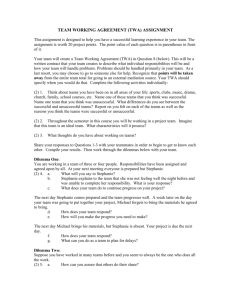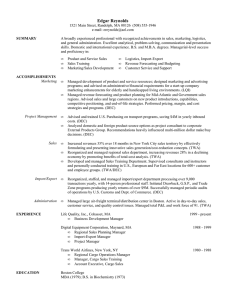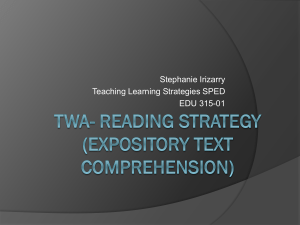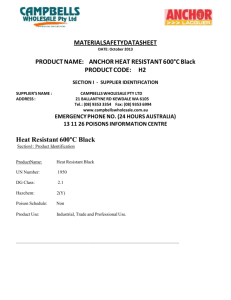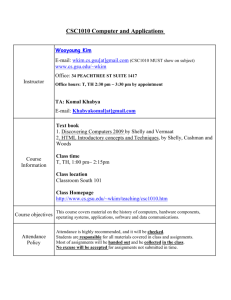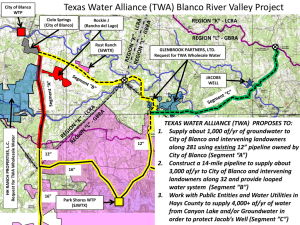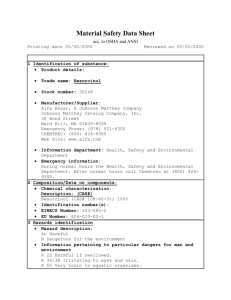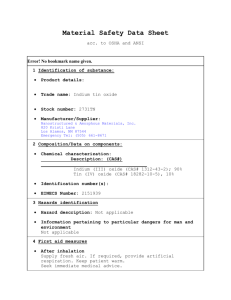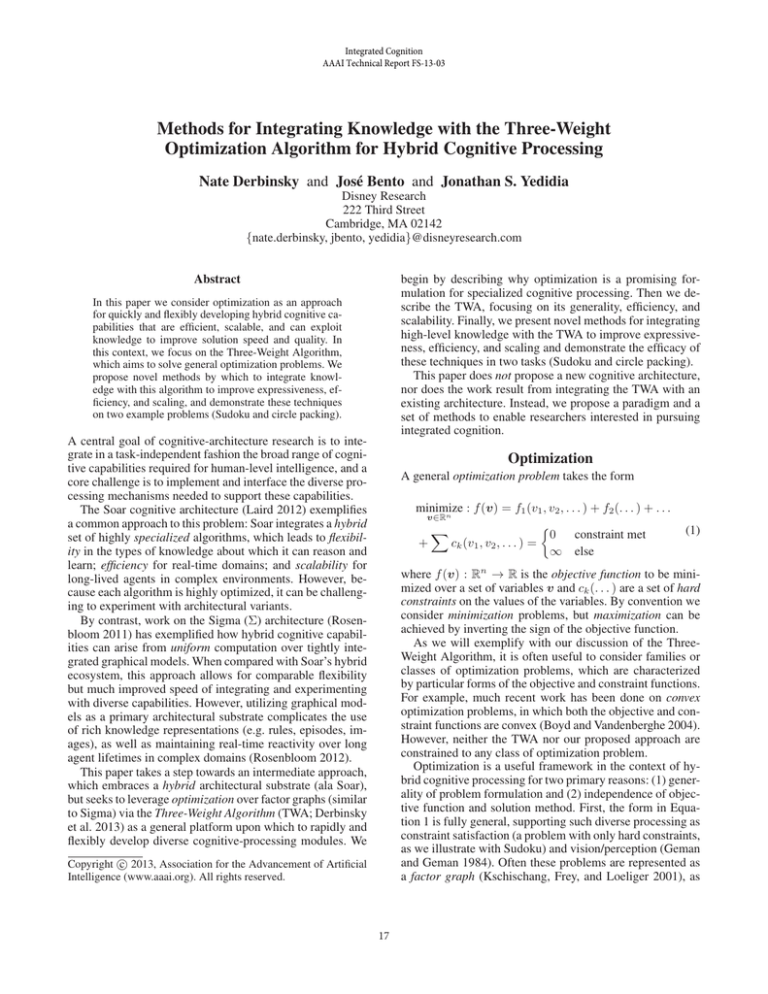
Integrated Cognition
AAAI Technical Report FS-13-03
Methods for Integrating Knowledge with the Three-Weight
Optimization Algorithm for Hybrid Cognitive Processing
Nate Derbinsky and José Bento and Jonathan S. Yedidia
Disney Research
222 Third Street
Cambridge, MA 02142
{nate.derbinsky, jbento, yedidia}@disneyresearch.com
Abstract
begin by describing why optimization is a promising formulation for specialized cognitive processing. Then we describe the TWA, focusing on its generality, efficiency, and
scalability. Finally, we present novel methods for integrating
high-level knowledge with the TWA to improve expressiveness, efficiency, and scaling and demonstrate the efficacy of
these techniques in two tasks (Sudoku and circle packing).
This paper does not propose a new cognitive architecture,
nor does the work result from integrating the TWA with an
existing architecture. Instead, we propose a paradigm and a
set of methods to enable researchers interested in pursuing
integrated cognition.
In this paper we consider optimization as an approach
for quickly and flexibly developing hybrid cognitive capabilities that are efficient, scalable, and can exploit
knowledge to improve solution speed and quality. In
this context, we focus on the Three-Weight Algorithm,
which aims to solve general optimization problems. We
propose novel methods by which to integrate knowledge with this algorithm to improve expressiveness, efficiency, and scaling, and demonstrate these techniques
on two example problems (Sudoku and circle packing).
A central goal of cognitive-architecture research is to integrate in a task-independent fashion the broad range of cognitive capabilities required for human-level intelligence, and a
core challenge is to implement and interface the diverse processing mechanisms needed to support these capabilities.
The Soar cognitive architecture (Laird 2012) exemplifies
a common approach to this problem: Soar integrates a hybrid
set of highly specialized algorithms, which leads to flexibility in the types of knowledge about which it can reason and
learn; efficiency for real-time domains; and scalability for
long-lived agents in complex environments. However, because each algorithm is highly optimized, it can be challenging to experiment with architectural variants.
By contrast, work on the Sigma (Σ) architecture (Rosenbloom 2011) has exemplified how hybrid cognitive capabilities can arise from uniform computation over tightly integrated graphical models. When compared with Soar’s hybrid
ecosystem, this approach allows for comparable flexibility
but much improved speed of integrating and experimenting
with diverse capabilities. However, utilizing graphical models as a primary architectural substrate complicates the use
of rich knowledge representations (e.g. rules, episodes, images), as well as maintaining real-time reactivity over long
agent lifetimes in complex domains (Rosenbloom 2012).
This paper takes a step towards an intermediate approach,
which embraces a hybrid architectural substrate (ala Soar),
but seeks to leverage optimization over factor graphs (similar
to Sigma) via the Three-Weight Algorithm (TWA; Derbinsky
et al. 2013) as a general platform upon which to rapidly and
flexibly develop diverse cognitive-processing modules. We
Optimization
A general optimization problem takes the form
minimize
: f (v) = f1 (v1 , v2 , . . . ) + f2 (. . . ) + . . .
v∈Rn
X
0 constraint met
+
ck (v1 , v2 , . . . ) =
∞ else
(1)
where f (v) : Rn → R is the objective function to be minimized over a set of variables v and ck (. . . ) are a set of hard
constraints on the values of the variables. By convention we
consider minimization problems, but maximization can be
achieved by inverting the sign of the objective function.
As we will exemplify with our discussion of the ThreeWeight Algorithm, it is often useful to consider families or
classes of optimization problems, which are characterized
by particular forms of the objective and constraint functions.
For example, much recent work has been done on convex
optimization problems, in which both the objective and constraint functions are convex (Boyd and Vandenberghe 2004).
However, neither the TWA nor our proposed approach are
constrained to any class of optimization problem.
Optimization is a useful framework in the context of hybrid cognitive processing for two primary reasons: (1) generality of problem formulation and (2) independence of objective function and solution method. First, the form in Equation 1 is fully general, supporting such diverse processing as
constraint satisfaction (a problem with only hard constraints,
as we illustrate with Sudoku) and vision/perception (Geman
and Geman 1984). Often these problems are represented as
a factor graph (Kschischang, Frey, and Loeliger 2001), as
c 2013, Association for the Advancement of Artificial
Copyright Intelligence (www.aaai.org). All rights reserved.
17
f1 tion problem is how to formulate individual modules, and
thus we revisit this comparison in the next section when discussing the specifics of the Three-Weight Algorithm.
v1 f2 …
The Three-Weight Algorithm (TWA)
…
fm The Three-Weight Algorithm (Derbinsky et al. 2013) is
based on a message-passing interpretation of the Alternating
Direction Method of Multipliers, or ADMM, an algorithm
that has gained much attention of late within the convexoptimization community as it is well-suited for distributed
implementations (Boyd et al. 2011). The TWA exhibits several properties that make it ideal for cognitive systems:
vn Figure 1: Factor graph of an optimization problem whose
objective function is f (v) = f1 (v1 , vn ) + f2 (vn ) + . . . +
fm (v1 , vn ). The red circles represent the variables, while the
blue squares represent hard or soft cost functions. If a line
connects a square to circle, that means that the corresponding cost function depends on the corresponding variable.
• General. The TWA operates on arbitrary objective functions (e.g. non-linear, non-convex), constraints (hard, soft,
mixed), and variables (discrete, continuous). It is known
to converge to the global minimum for convex problems
and in general, if it converges, the TWA will have arrived
at a feasible solution (i.e. all hard constraints met).
exemplified in Figure 1. Like other graphical models, factor
graphs decompose the objective function into independent
hard or soft cost functions, thereby reducing the combinatorics that arise with functions of multiple variables.
Another important reason to embrace an optimization
framework is that the objective function is formulated independently from the method by which the the corresponding
problem is solved. This abstraction supports flexibility in experimenting with objective variants without requiring significant effort to change a corresponding algorithm. However,
objective-function changes may impact the speed and success rate of a particular optimization algorithm, and thus it is
advantageous to use an optimization algorithm that can specialize to particular classes of objective functions, as well as
adapt solving strategies when provided higher-level sources
of knowledge (issues we discuss in greater depth later).
• Interruptible. The TWA is an iterative algorithm and, for
many problems, intermediate results can serve as heuristic
input for warm-starting complementary approaches.
• Scalable and Parallelizable. The TWA takes the form of
a decomposition-coordination procedure, in which the solutions to small local subproblems are coordinated to find
a solution to a large global problem. Boyd et al. (2011)
showed that this algorithmic structure leads naturally to
concurrent processing at multiple levels of execution (e.g.
MapReduce, multi-core, GPU).
Derbinsky et al. (2013) provide a full TWA description,
as well as its relationship to ADMM; however, the core of
the algorithm (see Algorithm 1) can be interpreted as an iteration loop that consists of two phases: (1) minimizing each
cost function locally and then (2) concurring on the result of
the local computations. Importantly, TWA messages operate
on the edges of the corresponding factor graph, as opposed
to directly on variables: this distinction raises the dimensionality of the problem, allowing the TWA to more effectively
search the variable space and avoid invalid solutions.
The minimization phase (line 4 in Algorithm 1) takes as
input a (msg, weight) pair for each edge and must produce,
for each edge, a corresponding output pair. The minimization routine must select a variable assignment in
Related Work Broadly speaking, optimization has been
applied in three main ways within the cognitive-architecture
community. First, optimization has been applied as a
methodological framework with which to rigorously traverse large modeling-parameter spaces, such as the spaces
of reward signals (Singh et al. 2010) and behavioral strategies (Howes, Vera, and Lewis 2007). When applied in this
way, the particulars of the optimization algorithm, as well as
integration within an agent architecture, are typically unimportant, whereas these issues are of primary focus in this paper. A second, related application of optimization has been
as an analytical framework of behavior, as best exemplified by such theories as rational analysis (Anderson 1991),
bounded rationality (Simon 1991), and optimality theory
(Smolensky and Legendre 2011). But again, this utilization of optimization typically does not necessitate a particular implementation-level algorithm, but instead offers evidence and organization for a set of functional capabilities.
Finally, work on Sigma (Rosenbloom 2011) formulates the
entire agent/architecture as an optimization/inference problem. This paper is much more narrowly scoped in comparison: we discuss optimization as an enabling platform for one
or more cognitive modules, independent of the implementation commitments of the architecture as a whole. However, a
sub-problem when considering architecture as an optimiza-
weightin
2
argmin f (v) +
(v − msgin )
2
v
(2)
The set of variable values must jointly minimize the sum of
the local cost function while remaining close to the incoming message set, as balanced by each edge’s weight. Furthermore, each edge must be assigned an outgoing weight,
which can be either 0 (intuitively no opinion or uncertain),
∞ (certain), or a “standard” weight (typically 1.0). Proper
use of these weight classes can lead to dramatic performance gains (Derbinsky et al. 2013) and is crucial for integration with higher-level knowledge (as discussed later).
The logic that implements this minimization step may itself
18
be a general optimization algorithm, but can also be customized to each cost function; custom minimization almost
always leads to improvements in algorithm performance and
is typically the bulk of the implementation effort.
The concur phase (line 10) combines incoming messages
about each variable from all associated local cost functions
and computes a single assignment value using a fixed logic
routine (typically a weighted average). After each variable
node has concurred, it is possible to extract this set of values
as the present solution state.
We do not go into the details of computing “messages”
(lines 6 and 12), but two ideas are crucial. First, each message incorporates both an assignment value and an accumulation over previous errors between the value computed by a
local cost function (line 4) and the concurred variable value
(line 10). Second, due to this error term, each edge, even
those connected to the same variable node, often communicates a different message: intuitively, each edge has a different view of the variable as informed by an aggregation
over local iteration history. The TWA has converged (line
15) when outgoing messages from all variable nodes do not
change significantly between two subsequent iterations.
(i.e. minimum-energy state) versus distributions in BP; (2)
continuous variables are native to the TWA, whereas special
treatment (e.g. discretization) is required in BP, which can
lead to scaling limitations; (3) because minimization routines can implement arbitrary logic and must only output
messages/weights for each edge, the TWA can handle constraints that would be very difficult to capture in BP; and
(4) whereas BP can converge to uninformative fixed points
and other invalid solutions, the TWA only converges to valid
solutions (though they may be local minima).1
Integrating Knowledge with the TWA
This section discusses two novel methods to integrate
higher-level knowledge into the operation of the ThreeWeight Algorithm. These techniques are general and, when
specialized for a particular problem, can lead to improved algorithm efficiency (iterations and wall-clock time), scaling,
and expressiveness of constraints and heuristics.
Reasoner Hierarchy
We begin by augmenting the TWA iteration loop in order
to introduce a two-level hierarchy of local and global reasoners, as shown in Algorithm 2. Local reasoners are implemented as a special class of factor within the problem graph.
They are able to send/receive messages like other factors,
but incoming message values always reflect the concurred
upon variable value. Their default operation is to send zeroweight messages (i.e. have no impact on the problem), but
they can also affect change through non-zero-weight messages. Furthermore, local reasoners have a Reason method,
which supports arbitrary logic. We term this class of reasoner “local” because, like other factors, it has a local view
of the problem via connected variables (and thus can be executed concurrently); however, the added reasoning step affords communication with global reasoners.
Global reasoners are implemented as code modules via
a single Reason method and are not connected to the problem graph, but instead have a “global” view of the problem
via access to the concurred values of any variable, as well
as any information transmitted via local reasoners. Global
reasoners can affect the problem via three main methods:
(1) requesting that local reasoners send non-zero-weighted
messages; (2) detecting problem-specific termination conditions and halting iteration; and (3) modifying the problem
graph, as discussed in the next section.
As alluded to already, a major reason for a hierarchy of
reasoners is to exploit parallelism in order to better scale to
large problems. Thus, where possible, local reasoners serve
as a filtering step such that global reasoners need not inspect/operate on the full variable set. In the Sudoku task, for
instance, this hierarchy yields an event-based discrimination
network, similar to Rete (Forgy 1982), whereby the local
reasoners pass along information about changes to possible
cell states and a global reasoner implements relational logic
that would be difficult and inefficient to represent within the
[first-order] problem factor graph.
Input: problem factor graph
InitializeMsgs();
2 while convergence criteria not met do
3
foreach factor do
4
ComputeLocalVariableAssignments();
5
foreach edge do
6
SendOutgoingMsgAndWeight();
7
end
8
end
9
foreach variable do
10
Concur();
11
foreach edge do
12
SendOutgoingMsgAndWeight();
13
end
14
end
15
CheckForConvergence();
16 end
Algorithm 1: An abstracted version of the Three-Weight
Algorithm for general distributed optimization.
1
All message-passing data is local to each edge within the
factor graph, and thus it is trivial to coarsely parallelize the
two main phases of the algorithm (i.e. all factors can be minimized in parallel and then all variables can be concurred
upon in parallel). For complex cost functions, fine-grained
parallelization within the minimization routine may lead to
additional performance gains.
The Sigma architecture uses a related algorithm for inference, the sum-product variant of Belief Propagation (BP;
Pearl 1982). Both the TWA and BP are message-passing algorithms with strong guarantees for a class of problems (the
TWA is exact for convex problems, BP for cycle-free graphical models) and both have been shown to be useful more
broadly. However, the TWA and BP differ along four important dimensions: (1) TWA messages/beliefs are single values
1
Derbinsky et al. (2013) more comprehensively compares
ADMM, the TWA, and BP.
19
Graph Dynamics
Input: problem factor graph
InitializeMsgs();
2 while convergence criteria not met do
3
foreach factor do
4
ComputeLocalVariableAssignments();
5
foreach edge do
6
SendOutgoingMsgAndWeight();
7
end
8
end
9
foreach variable do
10
Concur();
11
foreach edge do
12
SendOutgoingMsgAndWeight();
13
end
14
end
15
foreach local reasoner do
16
Reason();
17
end
18
foreach global reasoner do
19
Reason();
20
end
21
CheckForConvergence();
22 end
Algorithm 2: Extending the TWA with a two-level hierarchy of local and global reasoners.
1
Our second method for integrating knowledge is to support four classes of graph dynamics by global reasoners:
(1) adding/removing edges2 , (2) adding/removing factor
nodes3 , (3) adding new variables, and (4) re-parameterizing
factors. These actions allow for adapting the representation of a single problem instance over time [given experience/knowledge], as well as reusing a single mechanism for
multiple problem instances.
Removing graph edges and factors has two main effects:
(a) [potentially] changing variable assignments and (b) improving runtime performance. First, if an edge is disconnected from a factor/variable node, the outgoing variable assignments are now no longer dependent upon that input, and
therefore the objective cost may yield a different outcome.
Second, while removing an edge is analogous to sending
a zero-weight message, the system need no longer expend
computation time, and thus wall-clock time, per iteration,
may improve, as we see in both evaluation tasks.
The ability to add and remove edges allows the graph to
represent and reason about dynamically sized sets of variable. For example, in the Sudoku task, the TWA considers a
set of possible symbols for each cell, and can reduce its option set over time as logically certain assignments are made
within the row/column/square.
Supporting factor re-parameterization supports numerous
capabilities. First, it is possible to reflect incremental environmental changes without having to reconstruct the graph,
an important characteristic for online systems. It is also
possible to reflect changes to the objective function, which
may come about due to environmental change, task transitions, or dynamic agent preferences/goals. Additionally, repurposing existing factors helps keep memory costs stable,
which supports scaling to large, complex problems.
So, to summarize, graph dynamics improves the TWA
along the following dimensions:
The TWA weights each message to express reliability,
and in the context of symbolic systems, it is often useful
to extract certain information (weight = ∞). Local reasoners can filter for certain information, propagate implications
to global reasoning, and express certain results in outgoing
messages. In Sudoku, for example, propagating certainty via
the reasoner hierarchy maintains real-time reactivity for very
large problem instances by pruning unnecessary constraints.
So, to summarize, the two-level reasoner hierarchy improves the TWA along the following dimensions:
• Integration. Global reasoners can dynamically restructure and re-configure the problem graph to reflect
changes in the state of the environment, task structure, as
well as agent preferences, goals, and knowledge.
• Expressiveness. Changing edge connectivity supports
dynamic sets of variables without the necessity of enumerating all possibilities.
• Efficiency & Scalability. Performance of the TWA iteration loop depends upon the size of the graph, which can
be dynamically maintained such as to represent only those
factor nodes, variables, and edges that are necessary.
• Integration. Global reasoners can implement arbitrary
logic, including complex indexing structures, search algorithms, etc. Information is extracted from the problem, optionally filtered through local reasoners; processed via the
global reasoner; and then re-integrated through the API of
(msg, weight) pairs in local reasoners. Certainty weighting allows for fluid integration with processing mechanisms that operate over symbolic representations.
• Expressiveness. The two-level hierarchy supports relational reasoning over the inherently propositional factorgraph representation without incurring combinatorial explosion. The global reasoner can incorporate richer representations, such as rules, higher-order logics, explicit notions of uncertainty, perceptual primitives, etc.
Demonstrations
We now evaluate the TWA with our novel knowledgeintegration techniques in two tasks: Sudoku and circle packing. These tasks are not intended to represent cognitive processing modules - we are certainly not suggesting that cogni-
• Efficiency & Scalability. Operations of the local reasoners are parallelized, just as factor minimization and
variable-value concurrence in the problem graph. Furthermore, effective use of local filtering can greatly reduce the
set of variables considered by global reasoners, thereby
supporting scaling to large, complex problems.
2
Variable nodes are automatically pruned if there are no remaining incoming edges.
3
Removing a factor node has the effect of removing any incoming edges.
20
to a certainty-propagation algorithm falling out of the TWA
(Derbinsky et al. 2013). The TWA with certainty weights
proceeds in two phases: first, ∞ weights from initial clues
quickly propagate through the one-on constraints, and then
any remaining cells that could not be logically deduced are
searched numerically via optimization message-passing. We
now focus on how knowledge-integration can improve performance of the second phase for very difficult puzzles.
Integrating Knowledge We added to the problem graph
one local reasoner per cell with the express purpose of maintaining the set of possible digit assignments (i.e. those values for which there was not a certain message for the “off”
binary indicator variable) and, when a possibility was removed, communicate this information to a global reasoner.
The global reasoner utilized this information to improve
solver efficiency and performance by utilizing graph dynamics to reduce the problem search space. Specifically, when
a possibility was no longer viable logically, the global reasoner removed four edges (those that connected the binary
indicator variable to the constraints of the {cell, row, column, and square}), as well as any factors that were left
option-less in the process). These graph dynamics were intended to reduce the problem-graph size by removing constraints, as they became unnecessary, and thereby dramatically improve iteration time of the second phase of numerical solving, which is the major time sink for difficult puzzles.
To evaluate this benefit, we downloaded 32 of the hardest puzzles from an online puzzle repository4 and Table
1 summarizes final problem graph size (factors + variables), iteration-loop time (in msec. per iteration), and total solution time (in seconds) with and without this global
reasoner (results were gathered using a Java implementation of the TWA running on a single core of a 3.4GHz
i7 CPU with OS X 10.8.3). We see from this data that as
the problem increases in size, the global reasoner maintains a much smaller problem graph and corresponding iteration time: even as the baseline TWA crosses 50 msec.
per iteration, a commonly accepted threshold for reactivity
Figure 2: A typical 9×9 sudoku puzzle: (a) original problem
and (b) corresponding solution, with added digits in red.
tive architectures should have dedicated puzzle-solving capacities! Rather, these tasks allow us to demonstrate highlevel knowledge integration in the TWA, as well as show
benefits for expressiveness, efficiency, and scaling.
Sudoku
A Sudoku puzzle is a partially completed row-column grid
of cells partitioned into N regions, each of size N cells, to be
filled in using a prescribed set of N distinct symbols, such
that each row, column, and region contains exactly one of
each element of the set. A well-formed Sudoku puzzle has
exactly one solution. Sudoku is an example of an exact-cover
constraint-satisfaction problem and is NP-complete when
generalized to N × N grids (Yato and Seta 2003).
People typically solve Sudoku puzzles on a 9 × 9 grid
(e.g. see Figure 2) containing nine 3 × 3 regions, but larger
square-in-square puzzles are also possible. To represent an
N × N square-in-square Sudoku puzzle as an optimization
problem we use O(N 3 ) binary indicator variables (each
serving as a boolean flag) and O(N 2 ) hard constraints.
For all open cells (those that have not been supplied as
“clues”), we use a binary indicator variable, designated as
v(row, column, digit), to represent each possible digit assignment. For example, the variables v(1, 3, 1), v(1, 3, 2)
. . . , v(1, 3, 9) represent that the cell in row 1, column 3 can
take values 1 through 9.
For factor nodes, we developed hard “one-on” constraints:
a one-on constraint requires that a single variable is “on”
(value = 1.0) and any remaining are “off” (value = 0.0).
Furthermore, when appropriate, these constraints output
weights that reflect logical certainty: if there is only a single viable output (e.g. all variables but one are known to be
“off”), the outgoing weights are set to ∞ (otherwise, 1.0).
We apply one-on constraints to four classes of variable sets:
one digit assignment per cell; one of each digit assigned
per row; one of each digit assigned per column; and one
of each digit assigned per square. Prior work on formulating Sudoku puzzles as constraint-satisfaction problems (e.g.
Simonis 2005) has utilized additional, redundant constraints
to strengthen deduction by combining several of the original
constraints, but we only utilize this base constraint set, such
as to focus on the effects of reasoners and graph dynamics.
Sudoku is a non-convex problem, so the TWA is not guaranteed to solve the problem. However, prior work has shown
that it is effective for many puzzles, even those that are
very large, and that incorporating certainty weights leads
4
http://www.menneske.no/sudoku/eng
12X 10X N = 16 49.30% 26.18% N = 25 73.64% 22.01% N = 36 71.20% 48.19% N = 49 74.26% 80.83% Cores 8X 12 Axis Title 10 8 6X 6 4 4X 2 2X TWA +Knowledge TWA +Knowledge TWA +Knowledge TWA +Knowledge Figure 3: Degree of concurrency when solving Sudoku puzzles of different sizes without/with knowledge integration.
Improving linearly yields 1 vertical-unit block, and thus
ideal concurrency would fill the full vertical space.
21
N
Table 1: N xN square-in-square Sudoku puzzles solved without/with the reasoner hierarchy & graph dynamics.
# Puzzles
Avg. Final Graph Size
Avg. Iter. Time (msec/iter)
Avg. Solve Time (sec)
16
25
36
49
10
09
10
03
TWA
+Knowledge
TWA
+Knowledge
TWA
+Knowledge
005,120
018,125
051,840
127,253
00,460
03,121
06,032
11,173
01.48
06.19
22.19
52.48
00.80
00.92
04.12
10.54
000.17
075.96
061.36
124.59
000.12
005.25
009.03
020.08
in the cognitive-architecture community (Rosenbloom 2012;
Derbinsky and Laird 2009; Derbinsky, Laird, and Smith
2010), our reasoner is able to easily maintain a real-time
response rate for very large sudoku puzzles. Because our
global reasoner modifies the problem graph, and thus the numeric optimizer must now search over a different problem,
it was not obvious whether there would be an overall benefit
in terms of time-to-solution. However, the last two columns
show that adding knowledge always resulted in a faster solve
- up to more than 14× faster for N = 25.
We also evaluated a concurrent implementation of the
TWA that divides factors/variables into work queues using a naı̈ve scheduling algorithm: cost ∝ number of
incoming edges and we do not reschedule work (i.e.
queues can become unbalanced). Figure 3 illustrates the
degree to which this implementation can exploit added
cores: each stacked segment represents the proportion of
speedup in iteration-loop time (msec/iter), as calculated by
((time with 1 core/time with n cores)/n), and each vertical
tick is 1 unit tall (thus perfect linear speedup would be
represented by a stack that spans the full vertical space).
This data reveals two trends: (1) adding cores yields better performance; and (2) our implementation of the TWA
can take greater advantage of parallelism with larger problem graphs. The only exception to the former point was for
N = 25, cores = 2, in which the overhead of threading
actually hurt performance (shown as 0 height in the figure).
The latter point is especially relevant for evaluating graph
dynamics, as Figure 3 demonstrates significantly reduced
concurrent bandwidth when the problem graph is kept very
small (N ∈ {16, 25}): however, when comparing the best
average time-per-iteration, using graph dynamics was 6.6×
faster for N = 49, 4.5× faster for N = 36, 3.5× faster for
N = 25, and was nearly unchanged for N = 16.
Thus, to summarize our work in Sudoku:
in a square without overlapping. A large number of circles
makes finding a solution difficult, due in part to the coexistence of many different circle arrangements with similar
density. For example, Figure 4 shows an optimal packing for
14 circles, which can be rotated across either or both axes,
and the free circle in the upper-right corner (a “rattle”) can
be moved without affecting the density of the configuration.
To represent a circle-packing instance with N objects as
an optimization problem we use O(N ) continuous variables
and O(N 2 ) constraints. Each object has 2 variables: one
representing each of its coordinates (or, more generally, d
variables for packing spheres in d dimensions). For each object we create a single box-intersection constraint, which enforces that the object stays within the box. Furthermore, for
each pair of objects, we create a pairwise-intersection constraint, which enforces that no two objects overlap. For both
sets of constraints, we utilize zero-weight messages when
the constraint is not violated (i.e. the object is within the box
and/or the two objects are not intersecting).
Like Sudoku, circle packing is a non-convex problem, and
thus the TWA is not guaranteed to converge. However, prior
work has shown that the TWA is effective and that using
zero-weight messages to “ignore” messages from inactive
constraints dramatically reduces interference and thus the
number of iterations to convergence (Derbinsky et al. 2013).
Integrating Knowledge We made use of our knowledgeintegration methods for two distinct purposes: (1) drastically
improved scaling via r-tree integration and (2) macro movements via human assistance.
Using zero-weight messages for inactive constraints drastically improves iterations-to-convergence for circle packing; however, this method still requires O(N 2 ) intersection
constraints, and thus iteration-loop time (msec/iteration) still
prevents scaling to large numbers of circles. However, there
are numerous methods for efficiently detecting intersections
of spatial objects, such as r-trees (Guttman 1984), and since
the TWA tends to move circles in a local fashion, we implemented a graph-dynamics global reasoner that integrates an
r-tree to add/remove intersection constraints each iteration
(see Algorithm 3). To begin, we update the r-tree with the
locations of all circles via concurred variable values (line
1). We use axis-aligned bounding boxes (AABBs) to describe object locations and add a 5% “neighborhood” buffer
to each box: empirically we found that if constraints were
immediately removed from neighboring circles, there was
a high probability of cycles and thrashing, but by keeping
a small constant set of adjoining circles, the problem-graph
size was reasonably small (though non-decreasing for rea-
• Local reasoners were used to create an efficient and scalable discrimination network of possibility-set changes for
consumption by a global reasoner.
• A global reasoner responded to changes in possibilitysets in order to implement graph dynamics.
• These graph dynamics dramatically pruned the problem
set size (more than an order of magnitude for large puzzles) and had the result of improving efficiency and scaling, including reactive iterations for the largest puzzles.
Circle Packing
Circle packing is the problem of positioning a given number
of congruent circles in such a way that the circles fit fully
22
sonable densities) and the solver was robust to starting conditions and configuration densities. We then query for all object intersections (line 2) and categorize them as either existing (line 4) or new (line 5), based upon the current graph.
We then iterate over factors in the problem graph (line 9):
for existing intersections with corresponding factors, we do
nothing (line 11); and for those factors that are no longer intersecting (or in the neighborhood buffer), we remove those
factors from the graph and add to a “pool” of constraints
(lines 13-14). Finally, for all new intersections, we add a
constraint to the graph, drawing from, and re-configuring,
past [and now unused] factors, if available in the pool (lines
18-19). The key insights of this algorithm are as follows:
(1) only those objects that are in the graph need to be updated in the r-tree, as those are the only coordinates the TWA
could have altered; (2) the algorithm scales with the number
of active factors and intersections, which should be small
compared to the full O(N 2 ) set5 ; and (3) we pool and reparameterize unused factors to bound memory consumption.
positions, it can be difficult for the algorithm to make larger,
coordinated movements to escape local minima. Thus, we
implemented two sets of reasoners to incorporate human assistance, via a mouse, into the low-level circle-packing optimization. The first implementation required only a single
local reasoner: when a user clicked and dragged a circle in
the GUI (which reflected iteration results in real-time), the
mouse coordinates were sent as weighted messages to that
circle’s coordinate variables (graph dynamics were used to
connect the local-reasoner factor on-demand). Empirically,
we found that if human users knew high-level properties of
the final packing (e.g. they had seen a picture of a final configuration), they could easily communicate the macro structure via a series of circle movements, and then the TWA
would integrate this information and perform low-level, finegrained movements. The result was that humans working
with the TWA could consistently achieve packings that were
near record-breaking, and the human users would often interpret the experience as “fun” and “game-like.”
This type of interaction, however, did not work well when
we increased the number of circles to many thousands or
millions of circles. However, we still found that humans
could contribute high-level knowledge that was very useful,
but difficult to compute algorithmically within the TWA: areas with free space. Thus, we implemented a reasoner hierarchy: a global reasoner extracted meta-data from the r-tree
intersections to identify the circle with the largest current
overlap, the user would click a point in the GUI to identify a region of free space, and a local reasoner would transport (via weighted messages) the “distressed” circle to the
“vacant” region. Empirically this implementation seemed to
decrease iterations-to-convergence, but we have not verified
this hypothesis in a controlled setting.
For both of these reasoner implementations, we asked humans to contribute high-level task knowledge in the form of
mouse clicks. However, it is conceivable that human perceptual and motor models, such as those in EPIC (Kieras and
Meyer 1997), might achieve similar results in an automated
fashion and we are interested to further study this possibility.
Thus, to summarize our work in circle packing:
UpdateRTree();
foreach intersection do
3
if in graph then
4
Touch();
5
else
6
AddToAdditionQueue();
7
end
8 end
9 foreach intersection factor do
10
if touched then
11
do nothing;
12
else
13
RemoveFromGraph();
14
AddToFactorPool();
15
end
16 end
17 foreach factor in addition queue do
18
GetFactorFromPool();
19
AddToGraph();
20 end
Algorithm 3: Core logic for a global reasoner implementing dynamic-graph maintenance in the circle-packing task.
1
2
Using this approach, we have scaled our circle-packing
implementation to more than 2 million circles, which is
two orders of magnitude more than previously reported results6 . We have also achieved a record-breaking density of
0.82 with 9,996 circles in a unit square, the largest previously reported problem instance (previous density < 0.81).
For that problem, average iteration-loop time was less than
80 msec./iteration (4 cores, 3.4GHz i7) and the problem
graph never exceeded 1GB of memory, representing less
than 0.09% of the ∼ 50M nodes in the full problem.
In watching the iteration dynamics of circle packing, we
noticed that because the TWA makes local changes to circle
5
With a relatively small neighborhood buffer, the size of the
active set is O(N ) and related to the kissing number.
6
http://www.packomania.com
Figure 4: An optimal packing of 14 circles within a square.
Contacting circles are indicated by lines.
23
• A local reasoner integrated mouse input from humans.
Derbinsky, N.; Laird, J. E.; and Smith, B. 2010. Towards efficiently supporting large symbolic declarative memories. In
Proceedings of the 10th International Conference on Cognitive Modeling, 49–54.
Forgy, C. L. 1982. Rete: A fast algorithm for the many
pattern/many object pattern match problem. Artificial Intelligence 19(1):17–37.
Geman, S., and Geman, D. 1984. Stochastic relaxation,
gibbs distributions, and the bayesian restoration of images.
IEEE Transactions on Pattern Analysis and Machine Intelligence (6):721–741.
Guttman, A. 1984. R-trees: a dynamic index structure for
spatial searching. In Proceedings of the 1984 ACM SIGMOD International Conference on Management of Data,
47–57.
Howes, A.; Vera, A.; and Lewis, R. L. 2007. Bounding
rational analysis: Constraints on asymptotic performance. In
Gray, W. D., ed., Integrated Models of Cognitive Systems.
New York: Oxford University Press. 403–413.
Kieras, D. E., and Meyer, D. E. 1997. An overview of
the epic architecture for cognition and performance with application to human-computer interaction. Human-Computer
Interaction 12:391–438.
Kschischang, F. R.; Frey, B. J.; and Loeliger, H.-A. 2001.
Factor graphs and the sum-product algorithm. IEEE Transactions on Information Theory 47(2):498–519.
Laird, J. E. 2012. The Soar Cognitive Architecture. Cambridge: MIT Press.
Pearl, J. 1982. Reverend bayes on inference engines: A distributed hierarchical approach. In Proceedings of the Second
National Conference on Artificial Intelligence, 133–136.
Rosenbloom, P. S. 2011. Rethinking cognitive architecture via graphical models. Cognitive Systems Research
12(2):198–209.
Rosenbloom, P. S. 2012. Towards a 50 msec cognitive cycle in a graphical architecture. In Proceedings of the 11th
International Conference on Cognitive Modeling, 305–310.
Simon, H. A. 1991. Cognitive architectures and rational
analysis: Comment. In VanLehn, K., ed., Architectures for
Intelligence: The 22nd Carnegie Mellon Symposium on Cognition, 25–39. Erlbaum.
Simonis, H. 2005. Sudoku as a constraint problem. In Proceedings of the CP Workshop on Modeling and Reformulating Constraint Satisfaction Problems, 13–27.
Singh, S.; Lewis, R. L.; Barto, A. G.; and Sorg, J. 2010. Intrinsically motivated reinforcement learning: An evolutionary perspective. IEEE Transactions on Autonomous Mental
Development 2(2):70–82.
Smolensky, P., and Legendre, G. 2011. The Harmonic Mind,
Volume 1. Cambridge: MIT Press.
Yato, T., and Seta, T. 2003. Complexity and completeness
of finding another solution and its application to puzzles.
IEICE Transactions Fundamentals E 86(5):1052–1060.
• A global reasoner integrated an r-tree with the main iteration loop for greatly improved efficiency and problemsize scaling, as well as to inform human-assisted packing
via integration of intersection meta-data.
• Graph dynamics maintained the set of constraints,
as informed by an r-tree. These constraints were reparameterized to bound memory usage.
Discussion
The focus of this paper was to consider whether general
optimization could serve as a useful platform upon which
to quickly and flexibly develop a variety of cognitiveprocessing modules. In this context, we presented the ThreeWeight Algorithm as a candidate approach, along with novel
methods by which to usefully interface high-level knowledge with a low-level optimization framework in order to
improve expressiveness of knowledge, methods, and heuristics, as well as bolster algorithm efficiency scaling. In order
to exemplify these methods, we employed two tasks, independent of an agent or cognitive architecture.
Future work needs to proceed down [at least] three separate paths. First, these methods need to be evaluated within
actual cognitive-processing modules. For example, cognitive modelers could benefit from memory modules that are
flexible (via an arbitrary objective function) but are also
efficient for real-time use and scalable to complex tasks,
which might be accomplished via global reasoners that exploit state-of-the-art indexing techniques (Derbinsky, Laird,
and Smith 2010). Furthermore, these types of methods
seem to lend themselves to exploring the interface between
state-of-the-art perception algorithms and a symbolic cognitive architecture. Second, the TWA and our knowledgeintegration techniques need to be evaluated in context of
a running agent, with real-time environmental input and
changing knowledge, goals, and preferences. Finally, we
need to explore whether effective and efficient learning can
occur within modules that employ these methods.
References
Anderson, J. R. 1991. The place of cognitive architectures
in a rational analysis. In VanLehn, K., ed., Architectures
for Intelligence: The 22nd Carnegie Mellon Symposium on
Cognition, 1–24. Erlbaum.
Boyd, S., and Vandenberghe, L. 2004. Convex optimization.
Cambridge University Press.
Boyd, S.; Parikh, N.; Chu, E.; Peleato, B.; and Eckstein, J.
2011. Distributed optimization and statistical learning via
the alternating direction method of multipliers. Foundations
and Trends in Machine Learning 3(1):1–122.
Derbinsky, N., and Laird, J. E. 2009. Efficiently implementing episodic memory. In Proceedings of the 8th International Conference on Case-Based Reasoning, 403–417.
Derbinsky, N.; Bento, J.; Elser, V.; and Yedidia, J. S.
2013. An improved three-weight message-passing algorithm. arXiv:1305.1961 [cs.AI].
24


